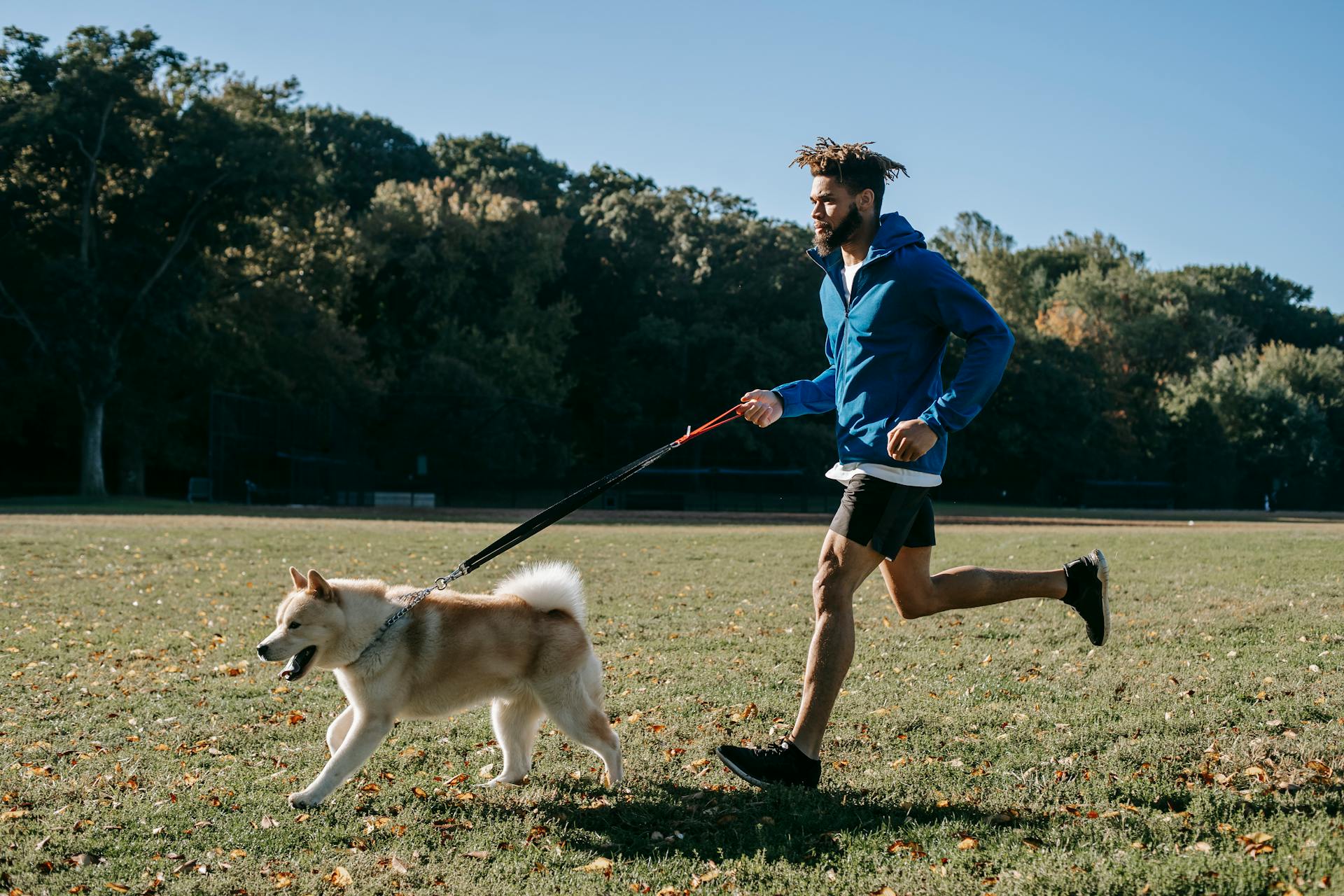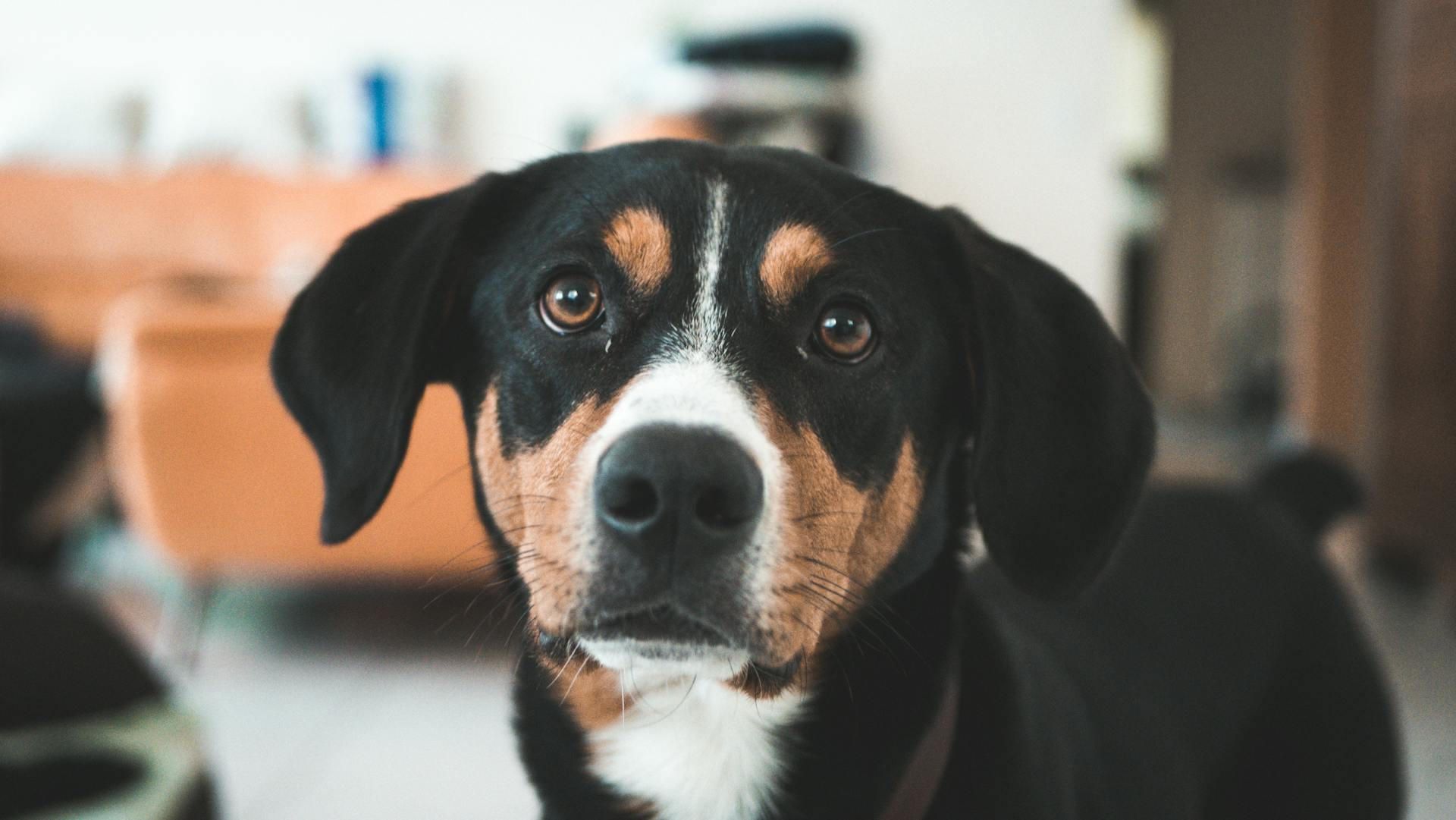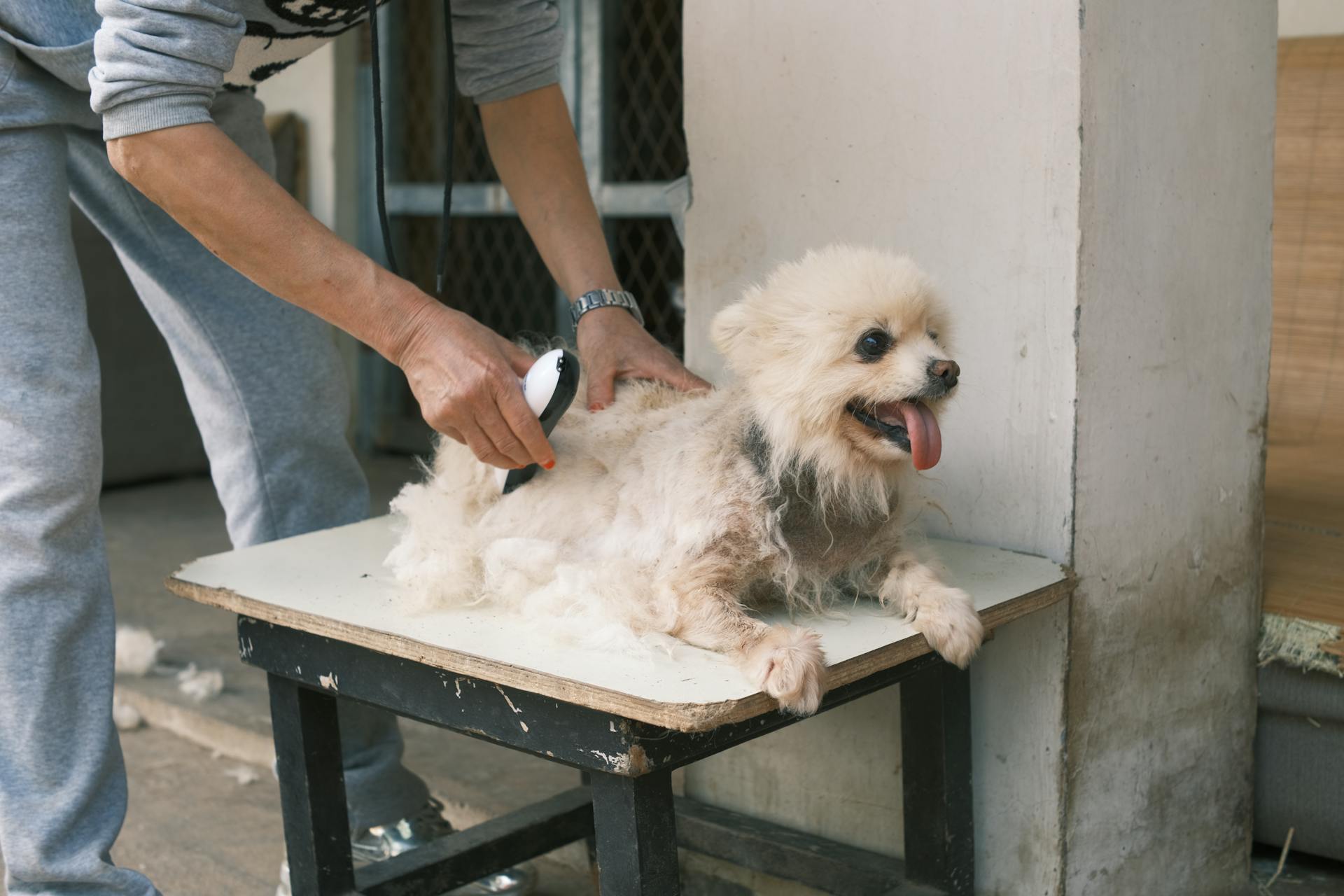
As a dog owner, you want to ensure your furry friend looks and feels their best. Regular grooming is essential, but it can be overwhelming if you don't know where to start.
Brushing your dog's coat is a crucial task that should be done at least twice a week. This helps prevent matting and tangling, especially for dogs with long hair.
A clean coat is not only visually appealing, but it also helps prevent skin issues. Regular brushing also reduces shedding, which is a bonus for dog owners who suffer from allergies.
Regular nail trimming is another essential task that should be done every 4-6 weeks. Long nails can cause discomfort and even lead to health issues.
A fresh viewpoint: How Long Is Dog Grooming School
Preparation and Planning
Before you start grooming your dog, it's essential to prepare everything you need. Gather all the necessary tools and supplies, such as a brush, nail clippers, shampoo, and towels.
A good grooming session starts with a clean dog, so bathe your dog before grooming. Brushing your dog regularly can prevent matting and tangling, which can be painful for your dog.
Regular grooming also helps to identify any skin irritations or other health issues early on. Keep an eye out for any unusual lumps or redness while you're grooming your dog.
Assess Your Needs
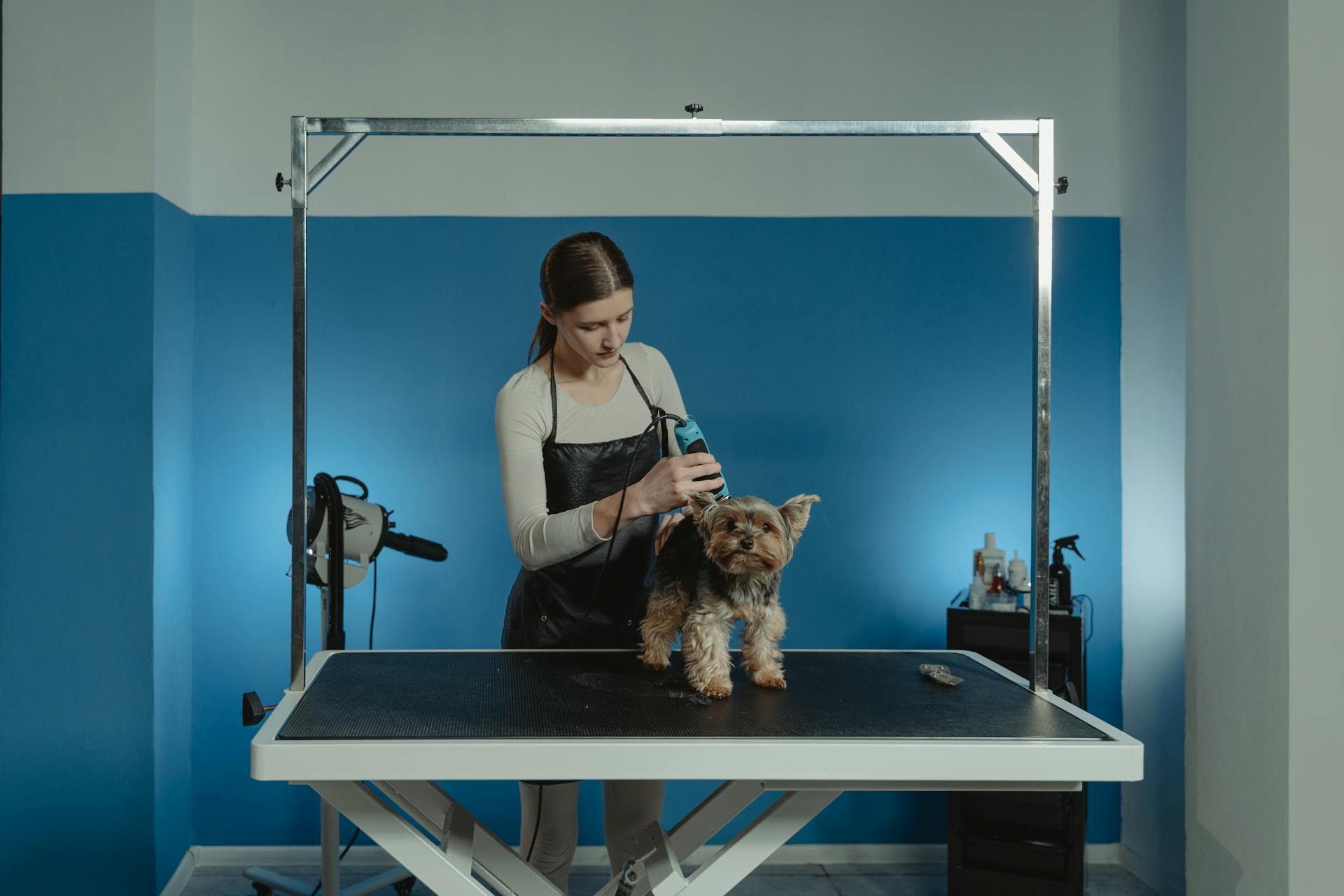
Determine what your dog needs based on its breed. For example, an Alaskan Malamute has different needs than a Poodle, and both are different from a Bluetick Coonhound.
You don't need to buy the most expensive supplies to keep your dog's coat in good condition. In fact, some of the best equipment can be made or purchased without spending too much money.
Consider the type of coat your dog has when choosing equipment. A medium-toothed comb is a good all-around comb, but a fine-toothed comb is better for dogs with thin hair, while a wide-toothed comb is better for dogs with thick hair.
A slicker brush is a good all-purpose brush, but a curry brush is better for dogs with short hair, and a pin brush is better for dogs with long single coats.
Some dogs require regular trims, while others don't need haircuts at all. For example, beagles and boxers don't need haircuts, but poodles and Pekingese do.
Readers also liked: Looking Good Dog Grooming
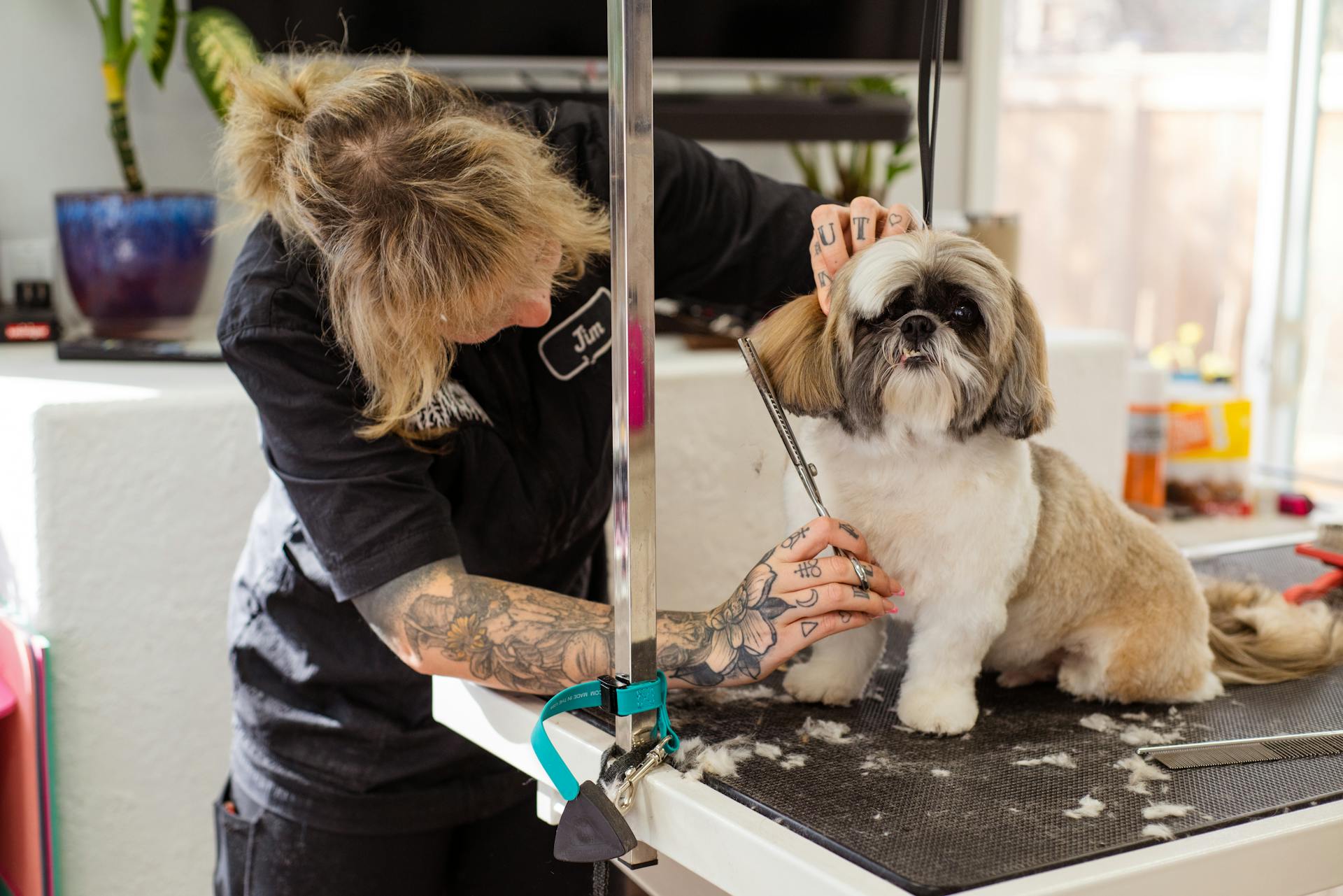
You'll also need to consider your dog's grooming needs when choosing equipment. If your dog has short hair, you'll need a brush that's more like a comb, while long-haired dogs need a brush with rounded tips to reduce pain while detangling.
Here are some basic dog-grooming supplies to get you started:
- Comb (medium-toothed, fine-toothed, or wide-toothed)
- Brush (slicker, curry, or pin brush)
- pH-balanced shampoo and conditioner
- Toothbrush and toothpaste made for dogs
- Dog toenail clippers and styptic powder
- Otic solution, forceps, and gauze
- Electric clipper (if your dog's coat needs to be clipped)
Final Checks
Finishing a grooming session with a thorough inspection is crucial. Always check your dog's ears and teeth to ensure they're clean and healthy.
Wipe your dog's ears out with a cotton ball moistened with rubbing alcohol or mineral oil. This may take some getting used to, especially if you haven't done it since your dog was a pup. Ears can be very sensitive.
Dogs can develop tarter and gum disease just like humans. Make teeth brushing a regular routine to save you and your dog from costly issues down the road.
Use a toothbrush and toothpaste made especially for dogs. Dogs don't spit, so the toothpaste needs to be safe to swallow.
Take a look at this: Plucking Ears Dog Grooming
Grooming Techniques
Brushing your dog regularly is essential to prevent matting and tangling of their fur.
Use a brush specifically designed for your dog's coat type to prevent breakage and reduce shedding.
A daily brushing session can help distribute skin oils, promoting healthy skin and a shiny coat.
Worth a look: Husky Blowing Coat before and after
Breed Coat Breakdown
When it comes to grooming, one of the most important things to consider is the breed of dog you have. The type of coat your dog has will determine how often you need to brush and bathe them.
Smooth coats, like those found on Basset Hounds and Dalmatians, require regular brushing to keep them shiny. They should be brushed at least once a week to prevent matting and tangling.
Wiry coats, like those found on Irish Terriers and Wire-haired Dachshunds, need to be washed and brushed frequently. They should be brushed daily to prevent matting and tangling, and washed every week to keep them clean.
For another approach, see: What Vaccines Do Dogs Need for Grooming?
Curly coats, like those found on Poodles and Bichon Frises, are prone to getting tangled and matted. They should be brushed daily to prevent matting and tangling, and washed every week to keep them clean.
Medium coats, like those found on Australian Shepherds and German Shepherds, are easily maintained with weekly brushing and monthly bathing. They are a great choice for busy owners who don't have a lot of time to dedicate to grooming.
Long coats, like those found on Cocker Spaniels and Collies, require regular brushing and bathing. They should be brushed daily to prevent matting and tangling, and washed every week to keep them clean.
Here's a breakdown of the different coat types and their maintenance needs:
- Smooth coat: regular brushing, weekly
- Wiry coat: daily brushing, weekly washing
- Curly coat: daily brushing, weekly washing
- Medium coat: weekly brushing, monthly bathing
- Long coat: daily brushing, weekly washing
Brushing
Brushing your dog is an essential part of grooming at home. It's especially crucial for medium- to long-haired breeds that are prone to tangles and mats.
Brushing can wildly improve the appearance of any coat type, including curly hair on breeds like Goldendoodles or Bichon Frises.
Removing excess hair through brushing helps control dog shedding.
Brushing also circulates blood flow, promoting healthy hair growth.
Stimulating the skin's natural oils through brushing increases shine.
Brushing keeps the coat looking neat and clean.
You should brush your dog at least 3 times per week.
A dog knot comb can be helpful for safely eliminating tough mats and knots.
For short-haired dogs, a curry brush is great for removing loose fur while giving your pup a relaxing body massage.
Explore further: Dog Grooming Pin Brush
Bathing
Bathing is an essential part of your dog's grooming routine. You'll want to establish a bathing routine to avoid stripping their skin and coat of its natural oils.
To decide if your furry friend needs a bath, ask yourself: How long has it been since their last bath? Have they been outside recently? Have they gotten dirty recently? What is their coat type?
Short-haired dogs don't need a routine wash, but if they get dirty, you can usually wipe them down with a damp cloth or grooming wipe and move on.
Here's an interesting read: Pomeranian Dog Bathing
Cleansing your dog regularly has several benefits: it keeps their skin and coat healthy, prevents odors, dirt, and debris from building up in the coat, and helps keep your home cleaner.
Here are some frequency guidelines for bathing your dog:
- Short-haired dogs: wipe down with a damp cloth or grooming wipe as needed
- Other dogs: once a week to every 2-3 months (or after a messy adventure)
Our Magic Coat Nourishing Oatmeal 2-in-1 Shampoo and Conditioner is a great option to relieve itchiness and revitalize all coat types.
Washing your dog at home can be challenging, especially if you don't have a shower head that you can use as a sprayer. A self-serve dog wash location can make the process easier.
To bathe your dog at home, gather the right products, including a shampoo and conditioner set made specifically for dogs. Pets have a different pH than humans, so human shampoo can irritate their skin and eyes.
Here are the steps to help your dog wash go smoothly:
- Gather the right products and find a good spot to set up your dog-washing station
- Coax your pet into the dog-washing station and use toys to distract them while you're working
- Warm the water to a comfortable temperature before wetting your dog
- Do two rounds of shampoo, rinsing thoroughly after each one
- Apply conditioner and let it soak in for a few minutes, then rinse thoroughly
- Wash around your dog's face with a washcloth in soapy water, avoiding their eyes
- Dry your dog off with a shammy or towels, and use a hair dryer on warm mode if needed
A pair of curved scissors can also be a good addition to your grooming toolkit, helping you create more of an angle to make the haircut look more natural.
Nail Trimming
Nail trimming is a crucial part of grooming that can be daunting, but it's key for a happy furry friend. Overgrown nails can lead to discomfort as your dog walks, runs, and jumps.
To avoid this, find your dog's nail quick before you begin trimming. The nail quick is a soft cuticle with the blood vessel and nerves that run through your dog's nail.
It's essential to take your time and practice patience when trimming your dog's nails. Acclimate your dog to the nail clippers or trimmers by letting them sniff the tools. Provide treats to reward progress along the way!
Here are the basic steps to follow:
- Hold the foot steady.
- Snip off a small bit of the end of each toenail below the quick.
- Repeat Steps 1 and 2 on each foot, and don’t forget to clip the dewclaws.
Ear Cleaning
Ear cleaning is an essential part of grooming your dog. To do it safely, gently hold your dog's head so that the open ear is exposed.
You'll need some otic solution to help clean the ear canal. Apply it as directed.
Using a sterile gauze pad or sponge, gently wipe out the excess solution. Don't scrub too hard, as this can irritate your dog's ears.
Here's a simple step-by-step guide to ear cleaning:
- Gently hold your dog’s head so that the open ear is exposed.
- Apply otic solution.
- Using a sterile gauze pad or sponge, gently wipe out the excess solution.
Trimming Your Coat
Trimming your dog's coat can be a daunting task, but with the right approach, it can be a breeze. Trimming your dog's hair is an important part of dog grooming, and it's essential to do it regularly to keep their coat looking tidy.
For smooth-coated breeds like the Basset Hound and Dalmation, regular brushing is a must to keep their coat shiny. You'll want to trim toward the paws to remove excess fur, and use rounded tip facial scissors to trim around the snout or between the ears and eyes.
The best time to give your dog a haircut is right after a bath, when their hair is damp and free of mattes and tangles. This makes it easier to manage and reduces the risk of cutting their skin.
If you're using clippers, run them in the direction of hair growth to avoid cutting your dog's skin. A clip-on guide comb can be a lifesaver for longer hair, helping you to get a neat and even cut.
See what others are reading: How to Trim a Dachshunds Nails
Some breeds, like the Poodle and Irish Water Spaniel, have curly coats that are prone to tangling and matting. These coats require regular washing and brushing to prevent matting and tangling.
Here's a quick rundown of the different coat types and their maintenance needs:
Remember, the most challenging part of grooming your dog is getting them to stay still. But with patience and practice, you can train your dog to enjoy the process, and even look forward to it.
Frequently Asked Questions
What are the 7 steps of grooming a dog?
Grooming a dog involves 7 essential steps: brushing their coat, trimming their hair, trimming their nails, checking their skin, checking their ears, teaching them to enjoy grooming, and bathing them only as needed. By following these steps, you can keep your dog clean, healthy, and happy.
How do you groom a dog at home for beginners?
For a beginner-friendly dog grooming experience at home, start by brushing and bathing your dog, then use blunt-ended shears or small clippers with guide combs to trim excess hair around sensitive areas. Begin with a number 10 blade for delicate areas and follow proper grooming techniques to ensure a safe and successful grooming session.
What are the recommendations for dog grooming?
Bathing your dog should be done at least every 3 months, but more frequently may be needed depending on their lifestyle and skin type. Regular grooming also includes brushing to prevent matting and skin issues, especially for breeds with loose facial skin or wrinkles.
Sources
- Dog Grooming For Dummies Cheat Sheet (dummies.com)
- How to Groom a Dog Easily at Home (Infographic) | Four Paws (fourpaws.com)
- grooming mitt (dgspetproducts.com)
- drying shammy (dgspetproducts.com)
- dog-washing area (hgtv.com)
- opt for clippers (cesarsway.com)
- grooming mitt (dgspetproducts.com)
- drying shammy (dgspetproducts.com)
- dog-washing area (hgtv.com)
- opt for clippers (cesarsway.com)
- New Salon Shopping List: How to Start a Dog Grooming ... (waggz.com)
Featured Images: pexels.com
